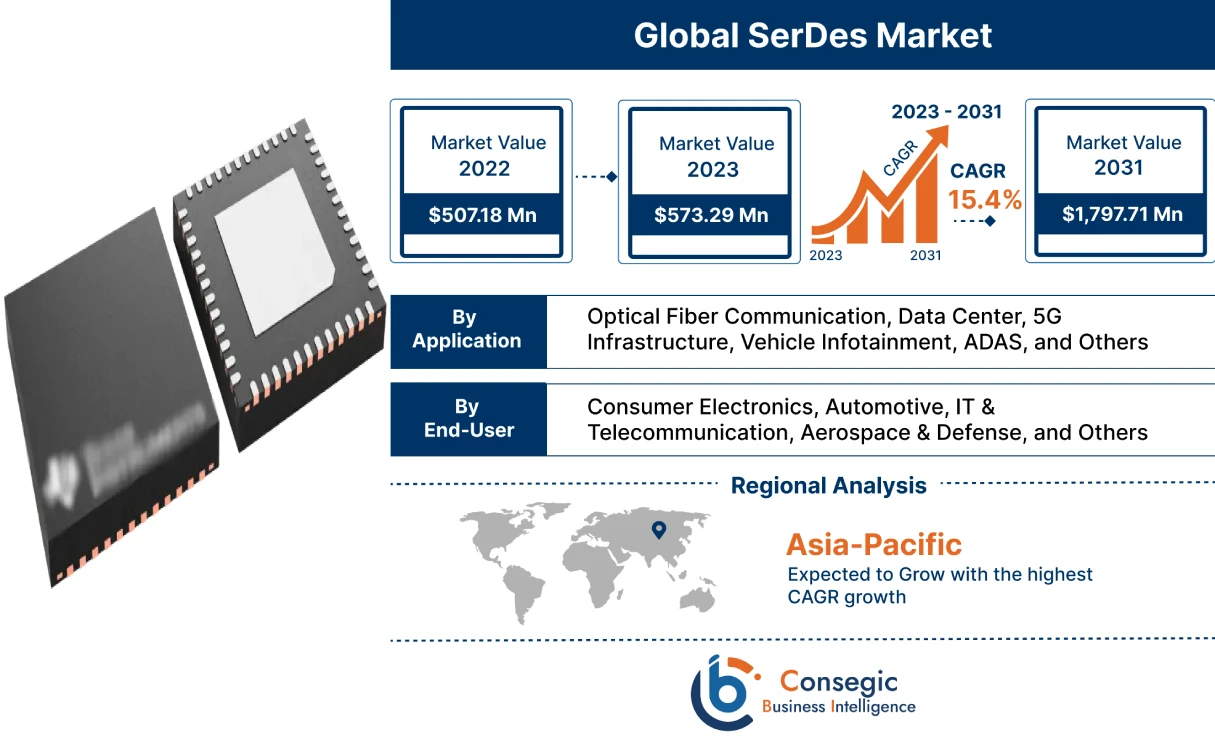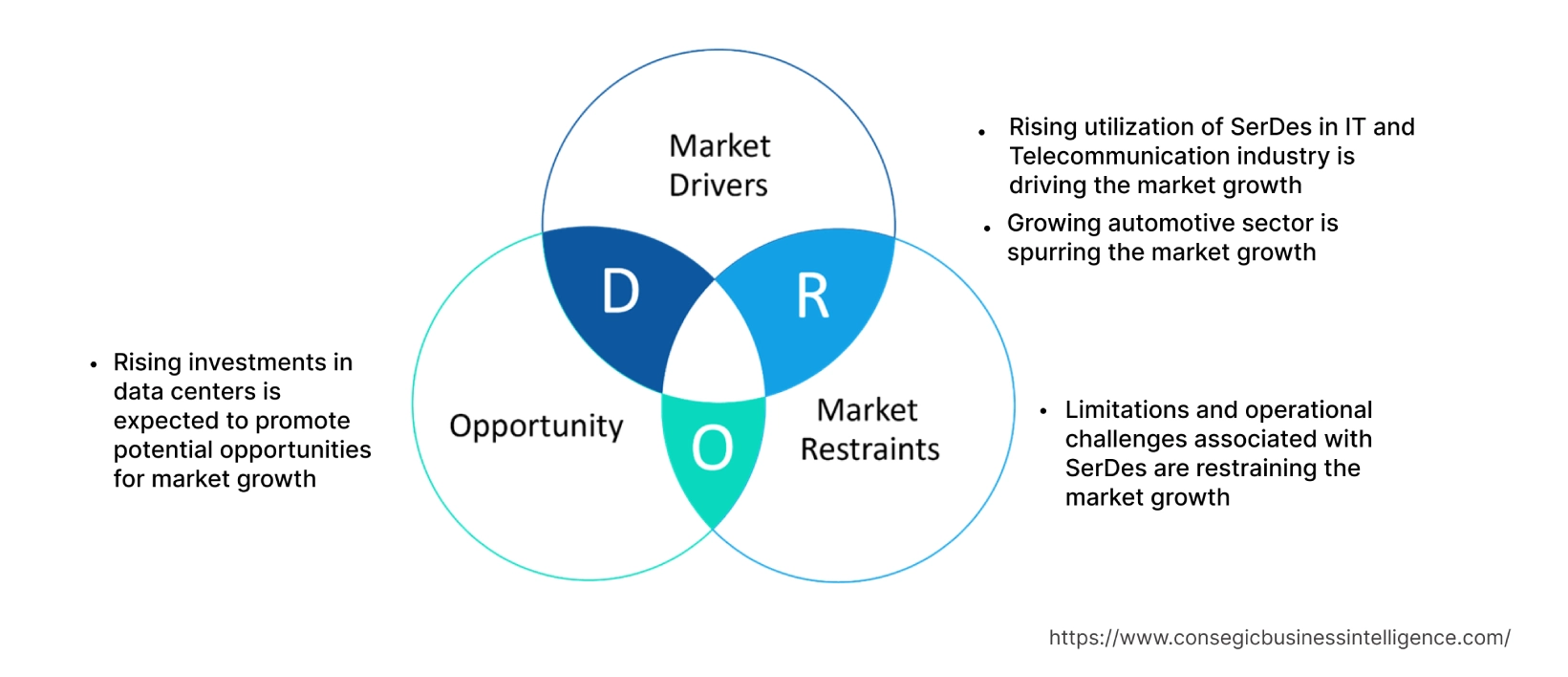SerDes Market Size :
SerDes Market size is estimated to reach over USD 1,797.71 Million by 2031 from a value of USD 507.18 Million in 2022 and is projected to grow by USD 573.29 Million in 2023, growing at a CAGR of 15.4% from 2023 to 2031.
SerDes Market Scope & Overview:
SerDes also known as serializers/deserializers are integrated circuits that are used in high speed data communication and networking. The SerDes components are crucial for transmitting and receiving data between digital systems and across physical interfaces such as cable or printed circuit boards. Moreover, SerDes enables the transmission of high volume of data while minimizing the power, cost, and board space usage associated with implementation of wide parallel data buses. The aforementioned characteristics of SerDes are key determinants for increasing its utilization in consumer electronics, automotive, it & telecommunication, aerospace & defense, and other sectors.
SerDes Market Insights :
SerDes Market Dynamics - (DRO) :
Key Drivers :
Rising utilization of SerDes in IT and Telecommunication industry is driving the market growth
SerDes is primarily used in the IT & telecommunication industry, particularly for applications including in optical fiber communication system, data centers, and 5G infrastructure among others. Moreover, SerDes is utilized in telecom transmission equipment including pseudo-optical switches and add-drop multiplexers for aggregating SONET/SDH streams for data transmission over cable or fiber to the core network.
Factors including the growing penetration of 5G infrastructure, rising expansion of data centers, and increasing adoption of smartphones and communication devices are among the primary aspects fostering the growth of the IT & telecommunication sector.
For instance, according to the Ookla 5G Map, the overall 5G network deployment reached up to 112 countries in November 2021, depicting an incline of 13% in contrast to 99 countries in November 2020. Furthermore, according to Ookla, the amount of 5G deployments increased significantly and reached up to 85,602 deployments in 2021 as opposed to 17,428 deployments in 2020.
Thus, the growing telecommunication industry is increasing the application of SerDes in telecom base stations and optical fiber communication system for providing high-speed data transmission, in turn driving the growth of the market.
Growing automotive sector is spurring the market growth
SerDes is used in the automotive sector for applications including automobile infotainment system and ADAS (advanced driver assistance system) among others. SerDes is among the primary connections used for automotive high-resolution, in-vehicle displays including infotainment display or back-up cameras. SerDes offers a point-to-point architecture with low baud rates, high bandwidth, and high orders of modulation, which are key determinants for increasing its utilization in automotive sector.
Factors including advancement in autonomous driving, rise in automobile production, and growing investments in automotive manufacturing facilities are among the primary determinants driving the growth of the automotive sector.
For instance, according to the International Organization of Motor Vehicle Manufacturers, the global passenger car production reached 61.59 million in 2022, witnessing an incline of approximately 8% in contrast to 57.05 million in 2021. Additionally, according to the European Automobile Manufacturers Association, passenger car production in the Europe Union reached up to 10.9 million in 2022, representing a growth of 8.3% as compared to 2021.
Hence, the rise in automobile production is driving the adoption of SerDes for application in automobile ADAS and infotainment system, in turn proliferating the growth of the market.
Key Restraints :
Limitations and operational challenges associated with SerDes are restraining the market growth
The implementation of SerDes is associated with certain limitations and operational challenges, which is a prime factor limiting market growth.
For instance, SerDes are usually associated with complexities and difficulties in designing and circuitry. SerDes often require a good RX CDR, TX driver, TX PLL, and RX front end for low data rates and efficient performance. The aforementioned components are complex analog subsystems that require a skilled team of analog/mixed-signal designers for design and development.
Additionally, SerDes manufacturing is usually associated with high cost, among which the primary expense of SerDes stems from design and verification. Further, the verification process can be quite complex at the system level, particularly for standards such as PCIe. Therefore, the above-mentioned limitations and operational challenges associated with SerDes are constraining the growth of the market.
Future Opportunities :
Rising investments in data centers is expected to promote potential opportunities for market growth
The rising investments in data centers is expected to present potential opportunities for the growth of the SerDes market. SerDes is often used in data centers for facilitating high bandwidth information exchange between cloud servers and data centers. Moreover, SerDes offers high-speed data transmission in data centers by enabling efficient and steady data flow. The above benefits of SerDes are further increasing its adoption in data centers.
Factors including the growing pace of digitalization, increasing deployment of cloud services, and rising investments in development of data centers are expected to facilitate lucrative growth aspects for the market.
For instance, in October 2022, IONOS Group SE, in collaboration with Fasthosts, launched a new data center with an initial investment of approximately USD 24.4 million in Worcester Six Business Park located in the United Kingdom. Additionally, in November 2021, Tencent Cloud launched its new data center in Brazil in order to fulfill the rising demand for digitalization in Latin America. The launch of the new data center provides highly reliable and stable cloud services to facilitate the growth of Brazilian and other Latin America-based businesses.
Hence, the rising investments in development of data centers is projected to drive the adoption of SerDes in data centers for high-speed data transmission, in turn stimulating opportunities for market growth during the forecast period.
SerDes Market Report Insights :
| Report Attributes | Report Details |
| Study Timeline | 2017-2031 |
| Market Size in 2031 | USD 1,797.71 Million |
| CAGR (2023-2031) | 15.4% |
| By Application | Optical Fiber Communication, Data Center, 5G Infrastructure, Vehicle Infotainment, ADAS, and Others |
| By End-User | Consumer Electronics, Automotive, IT & Telecommunication, Aerospace & Defense, and Others |
| By Region | North America, Europe, Asia-Pacific, Latin America, and Middle East & Africa |
| Key Players | Texas Instruments Incorporated, Semiconductor Components Industries LLC, STMicroelectronics, NXP Semiconductors, Broadcom, Rambus, ROHM Co Ltd., Semtech Corporation, Faraday Technology Corporation, Renesas Electronics Corporation, Keysight Technologies |
SerDes Market Segmental Analysis :
By Application :
Based on application, the market is bifurcated into optical fiber communication, data center, 5G infrastructure, vehicle infotainment, ADAS, and others. The 5G infrastructure segment accounted for the largest revenue share in the year 2022. SerDes is a functional block that is capable of serializing and deserializing digital data used in high-speed chip to chip communication. SerDes is primarily used in 5G infrastructure for aggregating radios and base stations into centralized networks for providing coverage over a continuous area. Moreover, SerDes offers ultra-low latency, efficient asymmetric operation, and ultra-low jitter required for 5G operation. The above benefits of SerDes are further increasing its application in 5G infrastructure.
For instance, according to the Department of Telecommunication of India, the total deployment of 5G base stations across India reached 324,192 as of August 2023, depicting a substantial growth of over 100% from 53,590 base stations in January 2023. Therefore, the rising development of 5G infrastructure is a prime factor driving the adoption of SerDes, in turn proliferating the growth of the market.
The vehicle infotainment segment is anticipated to register the fastest CAGR growth during the forecast period. SerDes is a primary connection used in vehicle infotainment systems including navigation and display systems, and video entertainment system among others. The characteristics of SerDes including low baud rates, high bandwidth, and high orders of modulation are increasing its application in vehicle infotainment system.
For instance, Renesas Electronics Corporation offers ISL34341 model of SerDes in its product portfolio that is specifically designed for application in vehicle infotainment system including navigation and display systems among others. Thus, the increasing development of SerDes for application in vehicle infotainment system is a vital factor expected to drive the growth of the market during the forecast period.
By End-User :
Based on the end-user, the market is segregated into consumer electronics, automotive, IT & telecommunication, aerospace & defense, and others. The IT & telecommunication segment accounted for the largest revenue share of 31.87% in the year 2022. Factors including the growing penetration of 5G networks, rising expansion of data centers, and increasing adoption of smartphones and advanced communication devices are driving the growth of the IT & telecommunication segment.
According to the Global System for Mobile Communications Association, the total 5G connections are projected to account for nearly 80% of total connections over the next five years. Further, according to GSMA, approximately 1.8 billion 5G connections are expected to be established by 2025, depicting a substantial increase from 500 million 5G connections in 2020. Thus, the growing consumer IT & telecommunication sector is increasing the utilization of SerDes in 5G base stations and optical fiber communication system, thereby driving the growth of the market.
Automotive segment is expected to witness the fastest CAGR growth during the forecast period. The growth of automotive segment is attributed to several factors including advancement in autonomous driving, rise in automobile production, and growing investments in automotive manufacturing facilities among others.
For instance, Keysight Technologies is among the SerDes manufacturers that offer high speed SerDes for utilization in the automotive sector. Keysight Technologies offers automotive SerDes for utilization in ADAS cameras and in-vehicle displays such as infotainment systems. Thus, the rising development of SerDes for deployment in automotive sector is among the key factors contributing to the growth of the market during the forecast period.
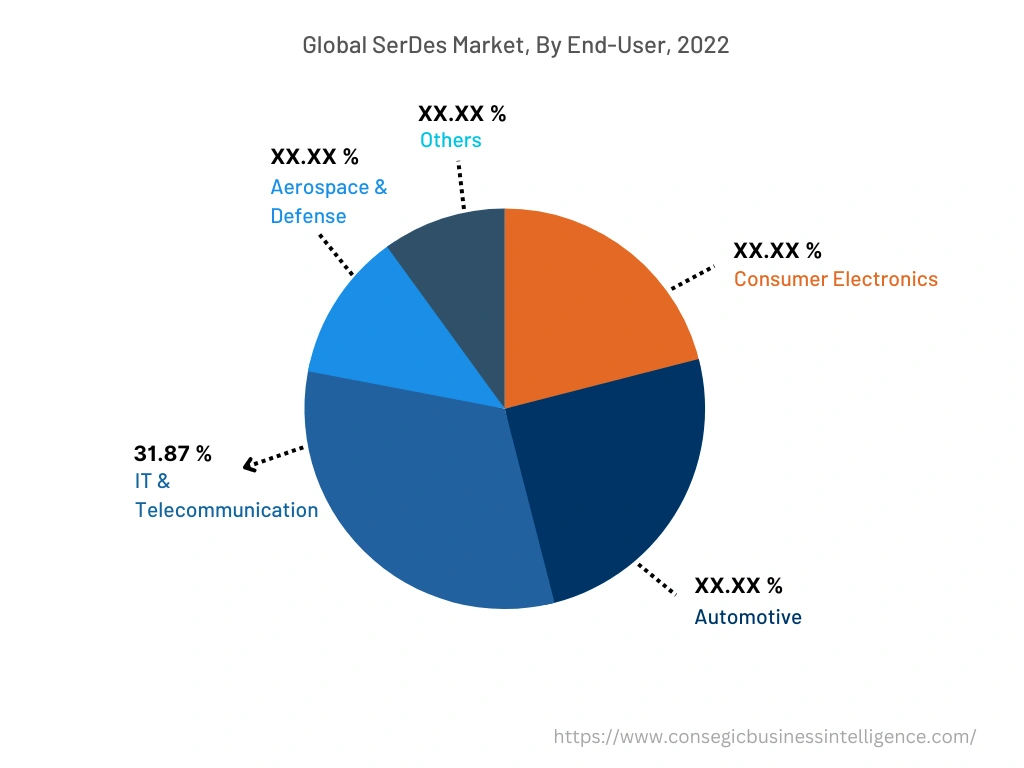
By Region :
The regional segment includes North America, Europe, Asia Pacific, Middle East and Africa, and Latin America.
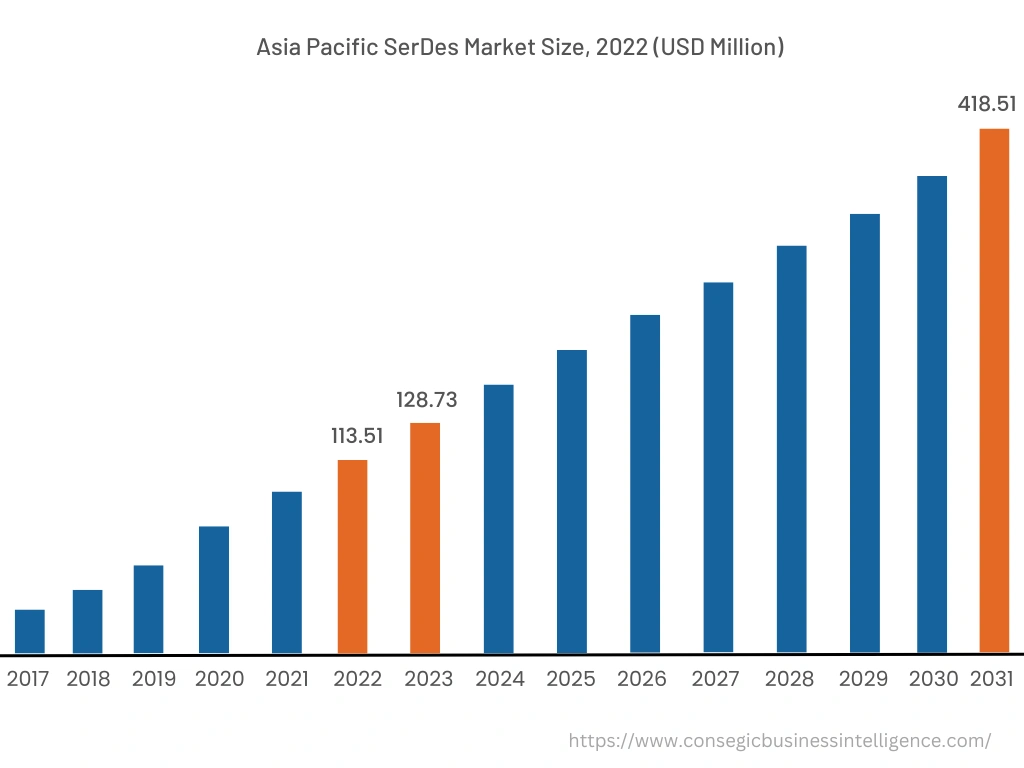
North America is estimated to reach over USD 668.93 Million by 2031 from a value of USD 188.72 Million in 2022 and is projected to grow by USD 213.32 Million in 2023. The market growth for SerDes in the North American region is primarily driven by its deployment in automotive, aerospace & defense, IT & telecommunication, and other industries. Additionally, the rising utilization of SerDes in telecommunication infrastructure including base station, and fiber optic communication systems for providing high speed data transmission are among the significant factors driving the market growth in the region.
For instance, according to the GSM Association, the overall deployment of 5G connections in North America reached approximately 140 million as of 2022. Thus, the growing telecommunication industry is fostering the deployment of SerDes for high speed communication and data transfer applications, in turn driving market growth in the North American region. Further, factors including the increasing investment in the field of electric vehicles and air defense systems are anticipated to foster opportunities for market growth in North America during the forecast period.
Asia-Pacific is expected to grow with the highest CAGR growth of 15.9% and is estimated to reach over USD 418.51 Million by 2031 from a value of USD 113.51 Million in 2022 and is projected to grow by USD 128.73 Million in 2023. In addition, in the region, the China accounted for the maximum revenue share of 26.9% in the same year.
The growing pace of industrialization and development is creating lucrative growth aspects for the market in the region. Additionally, factors including the growth of various industries including consumer electronics, automotive, IT & telecommunication, and others are driving the market growth for SerDes in the Asia-Pacific region.
For instance, according to the International Organization of Motor Vehicle Manufacturers, the total volume of automotive production across the Asia-Pacific region reached up to 50.02 million in 2022, depicting an incline of 7% as compared to 46.76 million in 2021.
Thus, the growing automotive sector in the Asia-Pacific region is driving the utilization of SerDes for application in automobile ADAS and infotainment system. The above factors are expected to boost market growth in the region during the forecast period.
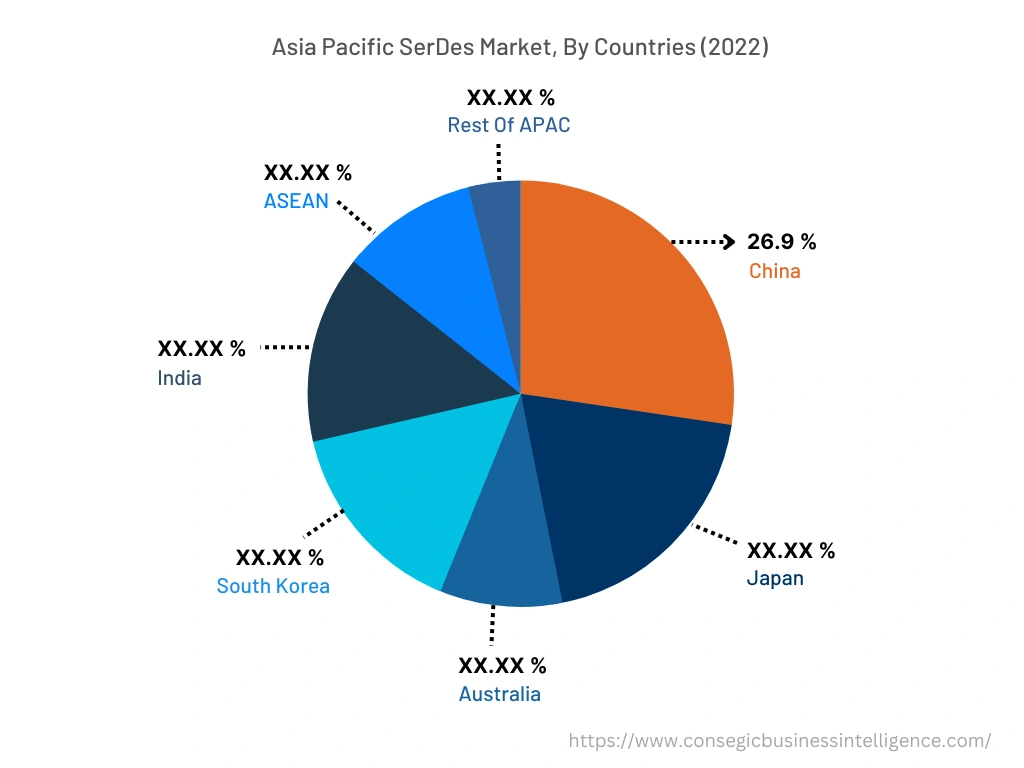
Top Key Players & Market Share Insights:
The SerDes market is highly competitive with major players providing SerDes to the national and international markets. Key players are adopting several strategies in research and development (R&D), product innovation, and end-user launches to hold a strong position in SerDes market. Key players in the SerDes market include-
- Texas Instruments Incorporated
- Semiconductor Components Industries LLC
- Faraday Technology Corporation
- Renesas Electronics Corporation
- Keysight Technologies
- STMicroelectronics
- NXP Semiconductors
- Broadcom
- Rambus
- ROHM Co Ltd.
- Semtech Corporation
Recent Industry Developments :
- In October 2022, ROHM launched its new SerDes ICs with full-HD compatibility that are specifically designed for application in multi-screen vehicle displays. The SerDes ICs enables efficient video transmission over multiple routes by utilizing a single serializer.
Key Questions Answered in the Report
What is SerDes? +
SerDes (also known as serializers/deserializers) refer to devices that are capable of taking single-ended, broad bit-width signal buses and compressing them into a differential signal that switches at a very high frequency rate as compared to wide single-ended data bus.
What specific segmentation details are covered in the SerDes report, and how is the dominating segment impacting the market growth? +
For instance, by application segment has witnessed 5G infrastructure as the dominating segment in the year 2022, owing to the rising adoption of SerDes in 5G infrastructure for aggregating radios and base stations into centralized networks for providing coverage over a continuous area.
What specific segmentation details are covered in the SerDes market report, and how is the fastest segment anticipated to impact the market growth? +
For instance, by end-user segment has witnessed automotive as the fastest-growing segment during the forecast period due to rising integration of SerDes in automobile ADAS and infotainment system among others.
Which region/country is anticipated to witness the highest CAGR during the forecast period, 2023-2031? +
Asia-Pacific is anticipated to register fastest CAGR growth during the forecast period due to rapid pace of industrialization and growth of multiple industries such as including consumer electronics, automotive, IT & telecommunication, and others.
